Chicago artists hold a long history in touring imaginative worlds within the mind and then translating these experiences into visually intoxicating materials. Visionary sojourns have surfaced in the art of Henry Darger, Lee Godie, the Hairy Who and a litany of other innovative artists working in sublime territory that is frequently considered little more than opaque fringe experiences upon initial inspection. A contemporary practitioner, Alan D. Caesar, worthy of multiple readings has been producing otherworldly comix that continue to extend these predecessor’s introspective investigations via an astute experimental approach to narrative coupled with a solid professional understanding of cartooning and printmaking. Recently, The COMP Magazine visited Caesar’s west Humboldt Park studio to discuss what’s so interesting about Oklahoma City, his protagonist Rena Rouge, the process of creating interesting and unique comics, and his recent project “Destroit All Monsters”.
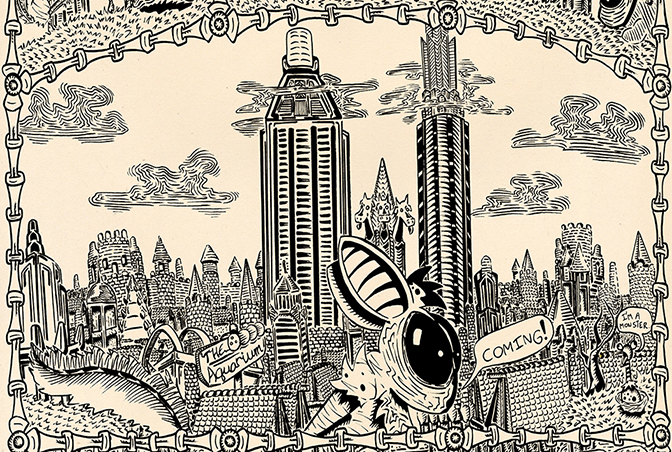
Alan D. Caesar, panel from Rena Rouge vol. 39, pen and ink drawing,
made in a very sad studio apartment in Lakeview, Chicago, IL, 2013
Note – the city of Holland of the Freds is the future city of Tulsa, Oklahoma in the Rena books, the real city has more art deco buildings then anywhere else in the U.S.A.
Lets start with Oklahoma City, Oklahoma. During our conversation, you noted that the city has a number of not widely known gems. What early experiences do see as having an influence on you current art practice?
Oklahoma was a really good place to start in regards to my artwork. One of my closest friends once rightfully commented that I’m very much a product of my ancestral homeland. It’s interesting because I’ve lived in Chicago for six years and I very much consider myself a citizen of the city and someone who is capable of surviving here. Chicago is my home. With that said Oklahoma is my Origin and it’s my family’s home. I’m a fourth-generation “Oklahoman” if such a word actually exists. There’s a lot of history there and it’s strange history, kind of an unsung history which draws me to it. I think it’s very easy to misinterpret Oklahoma as another middle of the country state with no real historical significance, that it’s an Indiana, Nebraska or really Illinois if Chicago wasn’t here. But Oklahoma is a kind of place where everything just ended up. The dinosaurs all seemingly decided to drop dead there at least if the amount of fossils, bones and oil are anything to go by. A good number of the Native American tribes were pushed there and will most likely die off there as their culture and genetic heritage is just muddied to the point of nonexistence. There’s a very nice monument for the tribes of Oklahoma at the state capitol. It’s an ever flowing fountain which broke about a week after being installed and no one bothered to fix it. The socialists were all there when the state was founded or at least soon after. They were pretty terrible farmers though so a lot of them ended up going to California to be treated like second-class citizens. Then the oil men came and they suck even harder at working the land and now the whole damn state will probably just fall in on itself in a few years from earthquakes. There is an underpinning of downfall to the state, a combination of bad circumstances, questionable choices in the face of opportunity and a seeming desire to exhaust all options until there’s literally nothing left. My work has always carried that understanding of that place that embodies a comedy of tragedies. I think my work both narratively and in practice depicts this idea of never being able to catch a break but still moving forward even if it is slowly leading toward a uncertain end. Around the 50s and 60s you had an unusual number of futuristic architectural buildings spring up in Oklahoma. We have churches shaped like eggs and banks inspired by the designs of Buckminster Fuller. I think it was just this combination of architects with a certain mindset being in an environment that had no historical architectural past that they were beholden too, along with investors that just kind of said yeah why the hell not. The end result is super fascinating because the rest of the structural environment is relatively boring. Schools of McMansions littered among a sea of strip malls but every once in a while you come across something that doesn’t exist anywhere else. Growing up I always just assumed that was normal. Cities just had certain fairly unusual pieces of architecture. It was only after living in Chicago and returning home that I realized just how weird some of these structures were and just how taken for granted they are. Space and architecture is hugely important to my work. There are obviously so many ways to make a narrative of sequential images but for myself so much time and effort goes into design of pages and the environment that the characters exist in. The background becomes just as important as characters or anything else. When I lived in Oklahoma especially during my high school years when I had the ability to drive there were many nights and days in the summer when I would go for drives. Not for long drives up to the countryside or anything like that. They were almost always based within Oklahoma City and were more about finding different paths to the same locations that were personal to me or to those architectural landmarks. It really just got me thinking of space and narrative from all angles. My work is two-dimensional in its inherent medium but all of my panels and scenes of my books are the editorial process of 3-D space. Every room and every environment is thought out in that way. I’m pretty sure I’ve only cheated once in my books in terms of environment and logic of that space but otherwise I try to have everything fit together as if it was an actual location both inside and out. I appreciate the unusual environment I grew up in and the complex inner workings of the place I live now not to show that in the worlds I’ve made. Yes this is probably as good a time as any to note that the Rena books at least volumes 37-39 take place in a future Oklahoma. Volume 39, in particular, really gives that away because that book will show a great deal of the architectural structures I grew up around. I thought it was only appropriate that the church of tomorrow actually get to make it in the time period it was named after. I think one great influence of my work that I would be remiss not to at least mention in passing is my mother’s profession. She’s worked in state government for all of my life and if there’s any place that the political satire of my work comes from it’s probably there. This is a topic I could probably speak about for days but I think it would be much simpler just to say yes government really is as organized and functions as well as a cart pulled by a herd of cats and at least one very belligerent rabbit.
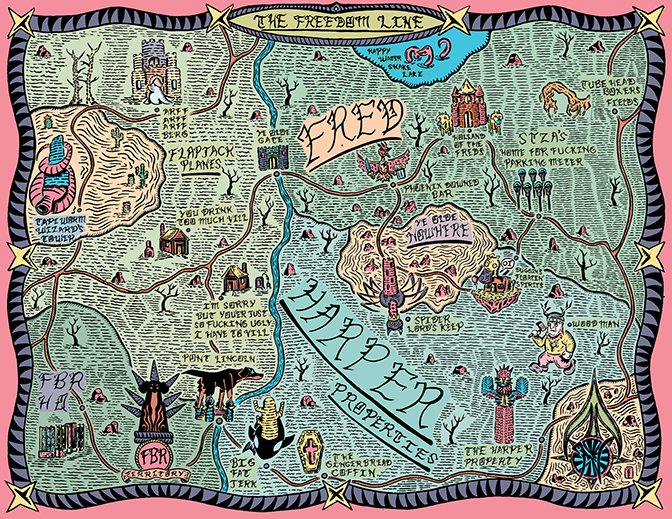
Alan D. Caesar, The Freedom Line, pen and ink, pre-press color proof for offset print,
made in a very sad studio apartment in Lakeview, Chicago, IL, 2013
Note – The Freedom Line is the area Rena Rouge 37-39 take place and is the future north east corner of Oklahoma.
Your aesthetic style is reminiscent of that seen in the work of Gary Panter (also from Oklahoma). Each page is densely arranged with narrative elements that wander between droll social commentary and sardonic non-sequiturs. Can you offer a summary of your process?
Panter from Oklahoma, I had no idea! Although the number of people who know who Gary Panter is in that state is probably pretty damn small. Although again I seriously think that state is secretly just into architecture and sculpture. I mean the state basically adopted Chihuly because he married someone from there it seems. It worked out pretty well for them though they got a three-story glass tower out of the whole deal. Anyway I’ll shut up about that weirdo state now, and answer your question although the short answer might be I only speak in sardonic non sequiturs. The way I create a book is actually fairly different than most. I think it’s much more normal for people to go in with a full script and a completely thumb nailed set of page layouts before ever drawing a full page. I’m sure there are also authors of comics where their narrative is almost fully automatic, a narrative that is much more loose and spun from plot beat to plot beat. I think my work lies somewhere in the middle of those two ideas at least for this current series of books. I’ve very intentionally made it so. Months if not years go into thinking about characters and the part of the world they inhabit, but I always consider everything at that stage to be acceptably ever shifting. At this point, I probably have the next 10 to 20 years’ worth of a career floating around in my mind, but how those stories will definitively take physical form is impossible to say at the moment. Although characters and ideas that I feel very strongly about will propagate themselves in art prints and other images long before they ever appear in the books. This is a way for me to make these elements and characters more concrete for the future. At the end of the day I think you have to be accountable for the artwork you make and not for the ideas you have, which leads me to the actual process of writing and drawing the books. Each book does have what I consider a roadmap. Narratively major plot beats and settings are determined at the beginning and then I give myself a particular rule set in which I have to tell that story. For example I construct all my stories around being physical books. As such I’m constantly playing by the rule of 4. The simplest traditional book design would be to fold a piece of paper in half thus producing 4 pages. You can then determine the length of your book by the number of pages divided by four or at least I do. As someone who produces and publishes their own work and likes to do so in experimental and what could be considered lavished ways i.e., neon inks, black metallics, and luxury papers. Cost is one of the ways to determine how long a book will be or at least what project I take on next like ones that are more profitable to help build up funds for some of the more elaborate projects. The other deciding factor is simply just the time it takes to produce artwork. My pages are controlled chaos and a page from initial to thumb nail stage to final inking can take between 16 and 24 hours. What I think most people would probably do in a 24 page book I’ll do in 8 page of a book. This is why you see a lot of my books are divided into chapters. Each chapter usually has a page count of 8 or if I feel there’s not enough content for one chapter but enough to warrant 9 in the next I will give and take. With these guidelines I now know how much of the story I have to tell and how much space I have to tell it in. From there I’ll write each page one or two at a time, thumbnail them out and immediately draw them. I’ll then go and re-evaluate how much the story I still have to account for in that particular chapter and plan accordingly in the layouts of my next few pages. Part of the reason I think my books work at all is I stay strict to this rule and I never break it only simply bend it. But that is one side of the harmony of my work, the control; the other side is the chaos. Part of not having a full script from the beginning is the ability to improvise all the way to the inking stage. It’s at that stage where a lot of the one off lines and little comments are added that really give the books that extra bit of character- little things about the scene that I don’t see until everything is set. That’s also where a lot of the world’s characters really seem to grow. While reading the books you’ll start to see these characters pop up in the background and then as you keep reading you’ll start seeing these characters show up again. The idea is that they’re having their own narratives that the books just aren’t following. But once involved I try to keep finding reasons to have them show up again or mentioned, to give people an update on what’s going on in their lives. By the end some could be just fun asides and some could be massively important to our main characters. But it comes from that idea that you are accountable for what is finally put on the page. So the whole thing may seem like a comic driving like a cart pulled by a herd of cats and one very belligerent rabbit, but it’s worth paying attention to all the little asides they not always as random as they seem.
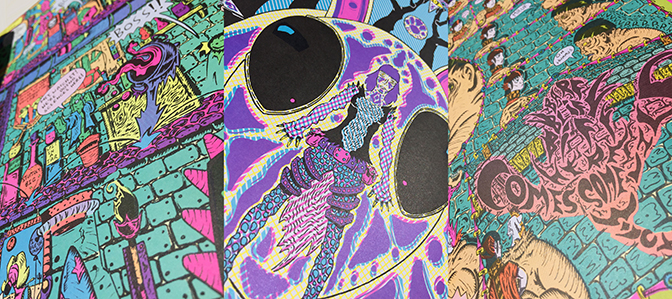
Alan D. Caesar, Rena Rouge vol. 37 color ed., offset book, printed at SAIC offset department, Chicago, IL, 2013
Note – I should have failed so hard printing this thing, like really this should not exist.
So, who is Rena Rouge? Where did she originate? What makes her tick? Do you have a determined trajectory for the character?
Rena is a girl like creature from the family line of Rouge. Although she decides to change her last name because she never could spell it right do to her dyslexia. I’m sure at some point the author of the book will get the memo to change the title over to Rena Rogue. She dropped out of wizard school because fuck those fools and she now travels the country of a former America in the 41st Century with her best friend Barnaby, a dragon that has the distinct look of a wacky water snake with the seemingly empty but all knowing eyes of God. This is a funny question to answer because Rena is actually a real person. Before I make one of her books I meet up with her to do a model shoot and then we go hang out with her dragon at a pinball arcade or bowling alley. That last sentence is only a semifictional statement in the sense that she’s very much based on a real person and we really do photo shoots for the book. The reality and the fiction do lineup to a degree. If I had to say what at their core makes Rena the fiction and Rena the reality is a positivity you don’t see in a lot of people. It’s a positivity that comes from someone who’s actually happy with who they are. There aren’t a lot deep seeded issues that control who she is and she hasn’t let her own individual struggles and trauma that we all as individuals have dictate who she is in a negative way. I’ve always admired the real life Rena for that and that’s partially the reason why I wanted to cast her as the main character. It’s something I do pretty regularly – cast actual humans as characters in my books. They are never one to one representations but there’s definitely DNA in there from the real life individual. So hopefully I’ve done a good enough job representing her in fiction. If I haven’t she’s been nice enough not to tell me I totally fucked up. I don’t know hopefully I didn’t make the fictional version too much of a jerk. If anything book Rena is just a bit frustrated with in the moment situations but I’ve always had a rule that anyone I have a character based off of is allowed to have veto power on aspects of the character. The Rena books are semi-collaborative in that way. Rena Rouge’s best friend Barnaby could have easily been a Griffin or a Leviathan rather than a Lambton Dragon. I gave the real Rena the option to pick one of the three without telling her what it was for. From the very beginning the books have been about dealing with unknown circumstances. I think it’s a message that’s very real life, for most people I just don’t think the world gives a shit about their plans. You have to try to figure out the best way to deal with your situation or prepare to have an unpleasant time. Rena has a pretty good personality and is able to deal with her cart, cat herd, belligerent rabbit life. So as a young woman in her 20s she is essentially a character that is just trying to live a satisfying life in this world with her big noodle worm of a friend. A lot of the conflict of the story comes from the world and the hyper circumstances of life that occur in that world for her and her friends. Initially, I had no plans to write so much of her story as I have committed to now. But very quickly while working with these characters I realized they were a group I really enjoyed telling stories about. This realization gave me the opportunity to really bring out their personalities’ over time by first showing them in stories that gave the reader a understanding of their characters and then putting them in narratives that shaped their goals and ambitions in life. It’s a method of telling the story that has the potential of being incredibly boring or at least a bit aimless at the beginning but since a wizard usually implodes every 8 to 10 pages in my work, Rena could be a character with the ambitions of a street side fruit vendor and the narrative would be at least mildly interesting. Regardless Rena does very much have a trajectory. She comes from a line that have worked very closely with the Foreign Bas Rouge (FBR), a group of French sheep dogs that within the narrative of the world are the ones that actually own and operate Downfall Arts and are producing the books. They are very much the glue that connects the overall timeline. And they are very important to how the world has come to this weird future state that is both mythical in setting yet still very linked to our modern culture. By association her family plays a role in that as well. There are some family lines such as Rena’s or other main characters like the Pooka witch, who also happen to be based on a very close friend of mine that may vary in importance when I’m telling a story in the “before Rena” volumes of the books but the FBR is a constant in one form or another. Overall the series doesn’t have a true single main character, even in the books that are mainly focused on Rena and her group – it’s such an ensemble cast everyone kind of gets their chance in the spotlight.
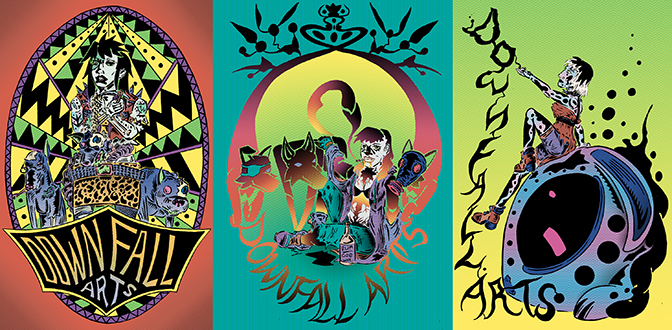
Alan D. Caesar, 3 downfall arts stickers Sid, Git, Pooka, pen and ink, pre-press color proof for print,
made at new wave coffee, Chicago, IL, 2016
Note – hope you like stickers… they will be everywhere.
“Destroit All Monsters” is your most recent project? Can you offer an overview of this “Microhistory Coloring Book for the Colorblind K-9”?
Destroit is a lot of things, an observation on the past and present of Detroit, a depiction of bad relationships on the verge of meltdown, a narrative that serves as a correspondence between the other Rena books and of those things I’m not sure how successful I was in depicting mostly because it seems to take someone six months to really read one of my books. For books that can be pretty inviting on the surface, they are pretty demanding in that way. But for a quick synopsis Destroit All Monsters takes place in a future Detroit in the year 2063. The city has been abandoned by most human life and is now predominantly inhabited by millions of pit bulls. It is a very brief golden time for the city as its new k-9 leaders begin the long road to rebuilding their city. Our viewpoint is mostly through the perspective of two of the remaining human inhabitants of the city, a young couple living in a shitty studio apartment filled with the discarded corpses of beers gone by and unreasonable amount of knife walls. What are knife walls you ask? Knife walls are what happen when you should re-evaluate your partner. The book actually takes place over roughly 8 to 12 hours of their lives as they try to scrounge up enough money to pay rent that month. During that 8 to 12 hours though you’ll see glimpses of the much grander story unfolding as you not only get to see how Detroit is doing under its dog leadership but also hints at the larger world outside the city. That’s where the micro history in the title comes from. There is a much more “historically” significant story to be told in this setting but that’s for another time. This book is much more personal in its observation of these two jerks. Although I’m well aware that’s probably disappointing to everyone involved given such a grand backdrop. I enjoy taking on stories like this though, we exist around history especially those of us who live in urban cultural centers. We pass locations that are historically important every day sometimes tremendously so. But you have to ask yourself how often do you contemplate how much of the metanarrative of society you comprehend while still living your own life and creating your own personal history. That was something that was important to me to put on display in this book. Our two main characters Jess and James are inhabitants of this world they even interact with a lot of historically important characters of this place but for them it’s just not that important after the fact. I’m sure these characters would be able to comprehend what they have been involved in and who they have been in contact with but that’s hindsight and it just seemed more appropriate and more human if they were oblivious to history as it happens. On the flipside that’s part of the reason I put a ton of research into capturing the cities past, pretty much every building that is shown in the book aside from the far-off shots of downtown and Seagull Street, are all based on buildings that are condemned or no longer exist. The same goes for the vehicles. They are all Detroit manufactured. The Detroit Free Press pages are all based on actual typography that publication used. It all links into my belief that environments have a story to tell. We may not always notice it but it’s there and sometimes it’s one that could be viewed as more important than even the story being presented on the surface. All of that probably should’ve been enough for this book but it also serves as a prequel, side story, and a continuation of the Rena Rouge books because you know I can’t make anything simple. It’s kind of secretly the third Rena book. I really like the idea of the second Rena book volume 38 and Destroit having this private conversation with each other. Seemingly random jokes like the seagulls attacking in 38 suddenly make sense in light of the events of Destroit. The inclusion of the time traveling characters as well was also part of this conversation characters that bounce between the two books playing roles in each. Obviously the concept of time travel isn’t anything new but I’m not sure about time and book travel despite the Rena and Destroit association with one another. They’re intentionally different books presentationally. One is a brightly colored far off future bordering on fantasy while the other is a black and white coloring book set against very real and heavily researched architecture and locations. Rena is more mystical where Destroit is during a time when our world is on the brink of change over to Rena’s time. This was one of the main goals I had for the book. I knew there was a great deal of history to this world I had begun crafting and I didn’t think there was a more appropriate way of presenting it than just show it center stage and really get the readers to understand just how elaborate structurally and narratively I’m trying to take my work. It’s early enough along in my career that I thought it was important to make sure people didn’t associate me with just being the guy who makes brightly colored whacky cart cat rabbit fun books. Destroit is a small taste of what I have to say aside from that.
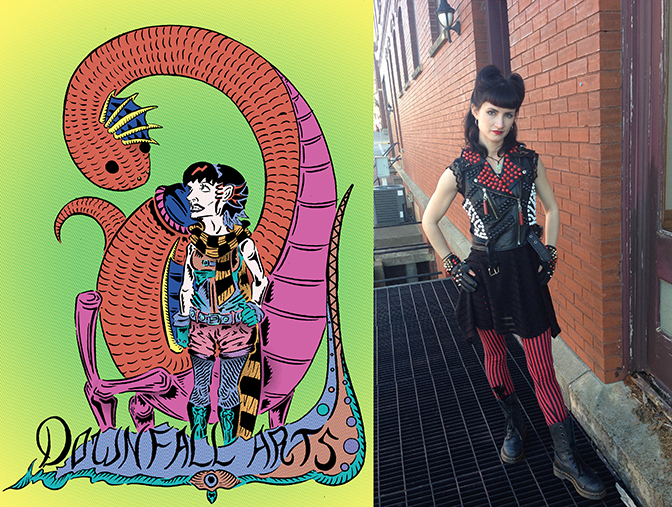
Alan D. Caesar, Downfall arts sticker Rena and model shoot of the desert queen vest (model-Serena Engle), pen and ink, per-press color proof for print and photography,
made at new wave coffee, Chicago, IL and shot at Guthie, Oklahoma, 2015-2016
Note – aside from the vest Rena put together the look of the Desert Queen that shows up in Destroit.
What do you value most in your comics practice?
What I would value most for my artistic practice would be to sit down and work on writing, drawing, and coloring books. I seriously don’t think anything could make me happier in this world than just being able to work on comics for like 10 straight hours a day. Having to do everything though I’m kind of pulled in 1,000 directions at once and I guess I can live with that too except my life likes to try to destroy everything I have every five months or so. It’s kind of a constant oh now you’re homeless or oh we’re going to lay you off but keep working for us because we’re really bad at committing to anything or did that car wreck kill you because it should’ve. It can be hard to sleep at night or get up in the morning when you look at your life and you see a 1,000 cats turning and writhing one direction or another as you grasp upon a stick swing it to and fro desperately demanding them to march your cart of dreams into the future as you look down at a puddle of blood and mud and see your reflection as you realize you are the rabbit. But yeah, no real complaint I’m pretty happy and I’m doing OK so far.
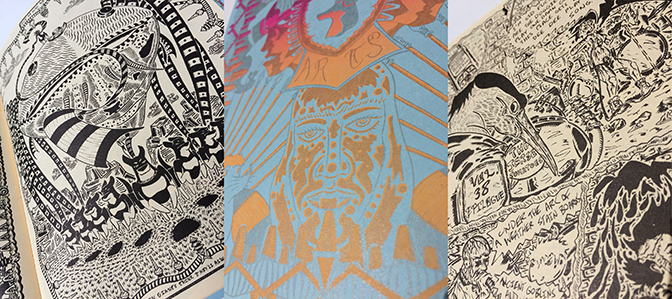
Alan D. Caesar, 6- Rena Rouge Vol. 38 black and ivory ed./ offset book/ printed at SAIC offset department, Chicago, IL, 2013
Note – This is the first book I printed every part of the next is being Rena vol 37 colored ed.
In addition to C.A.K.E. (Chicago Alternative Comics Expo), what do you have planned for the remainder of 2016?
For shows this year I’ll be tabling at the Kansas City Zine Con in September. I did their show last year and was really pleasantly surprised by how supportive this community is. Definitely a show people should check out. Aside from that, I’m mainly focused on getting more work printed. The last two years have been a bit frustrating for me in the sense that it was only at the beginning of this year that I was really able to start printing my work again so there is a bit of a backlog of work that can become physical art now. There is this little mini comic I made a year or so back called the Bestiary. I was really dissatisfied with my original print run and I never really put more than maybe 70 of these out into the world. I recently just added new pages to it and I’m planning to do a second printing on my new press that meets my quality standards. I always hate saying something will be out soon because that’s a guarantee that something awful will happen, but barring any horrible life trauma people should be able to own it sooner rather than later. I’m also doing a full color version of Rena volume 38, I’m about halfway done with coloring it and will be really excited when I can put that behind me because that’s also long-overdue. Also I was offered an opportunity to do a book for Jab, the journal for artist books. I’ll be submitting my concept for that really shortly – after the writing of this interview actually. The concept behind that book is a group of wolves come across an old letterpress shop and begin to start the business up again. Soon they enter into a contract to manufacture novelty coasters for a group of beavers and the business partnership goes horribly wrong and then everything just turns into World War I. Aside from that I’ll continue to work on Rena Vol 39 and oh yeah I just drew this picture of a cart pulled by a herd of cats and one very belligerent rabbit.
Additional artworks by Alan D. Caesar:
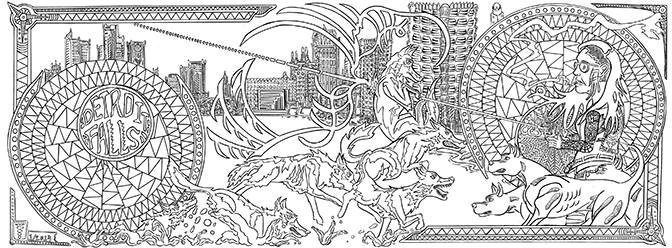
Alan D. Caesar, Detroit Falls, pen and ink drawing, Oklahoma City , OK, 2014
Note – This is the first piece of art made that would turn into Destroit.
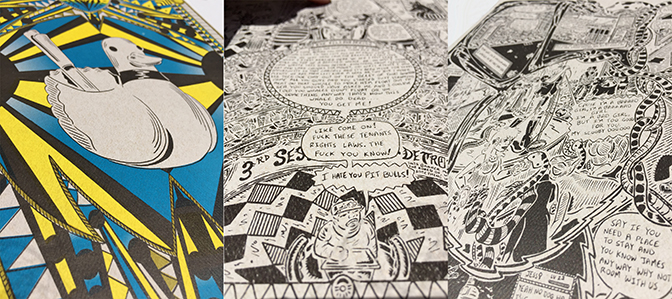
Alan D. Caesar, Destroit All Monsters, offset book, printed at Downfall Arts, Chicago, IL, 2016
Note – I almost died a really awful death trying to make this book. It should not exist.
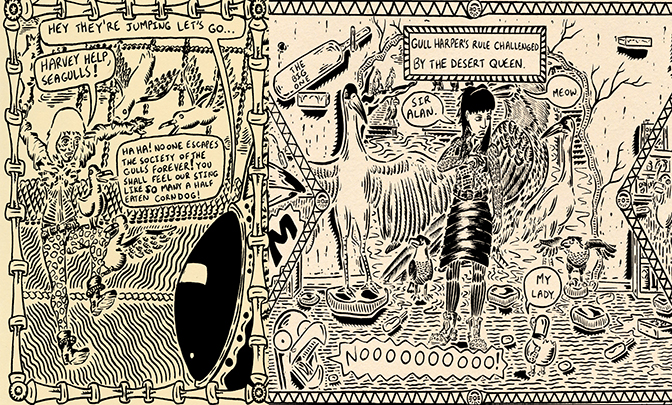
Alan D. Caesar, Panels from Rena vol. 38 and Detroit All Monsters, pen and ink drawing,
made at SAIC and new wave coffee Chicago IL, 2013-2015
Note – remember that time when grandmother murdered all those seagulls, that’s why your having a bad day.
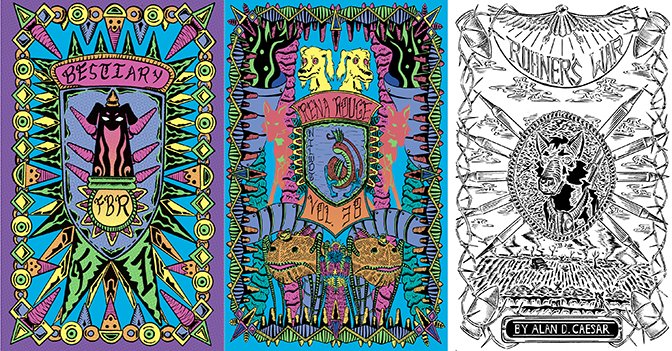
Alan D. Caesar, Covers bestiary, Rena Rouge vol. 38, Rohner’s War, pen and ink, pre-press color proof for print,
made at SAIC and new wave coffee Chicago, IL, 2013 and 2016
Note – That Rohner’s War wolf is not having a good day.
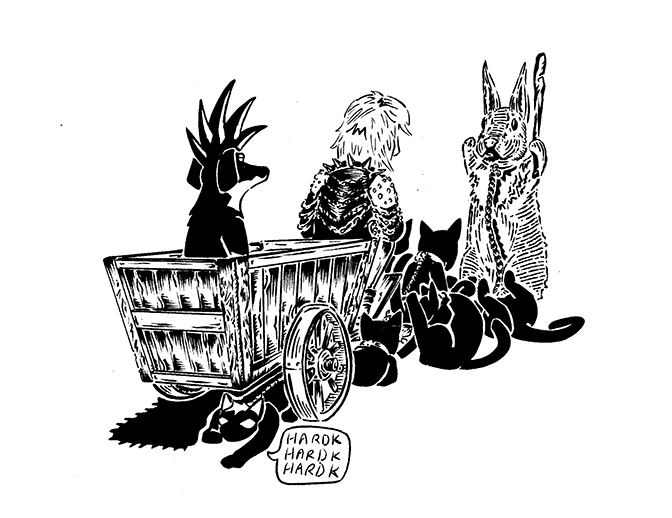
Alan D. Caesar, A cart pulled by a herd of cats and one very belligerent rabbit, pen and ink drawing,
made at new wave coffee, Chicago, IL, 2016
Note – I’m going to go jump in the river now.
For additional information on the work of Alan D. Caesar, please visit:
Mattreaaess Seal – http://downfallarts.tumblr.com/
Alan D. Caesar – https://www.tumblr.com/search/alan%20d.%20caesar
Downfall Arts – http://www.downfallarts.com/
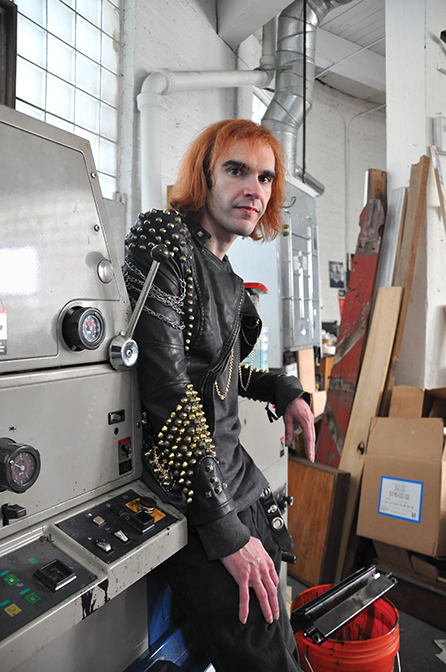
Alan D. Caesar, cartoonist, Chicago, IL, 2016
Artist interview and portrait by Chester Alamo-Costello


